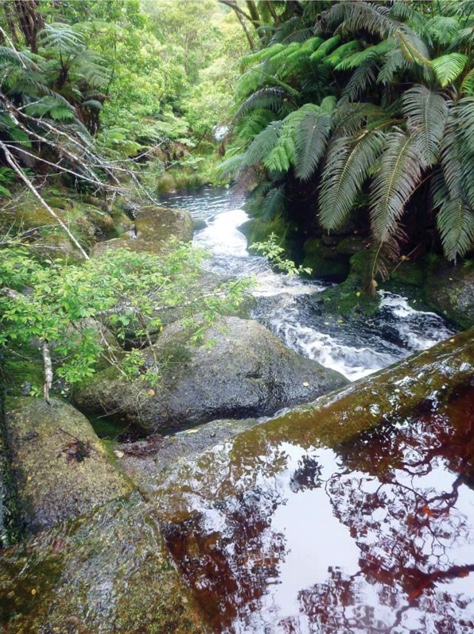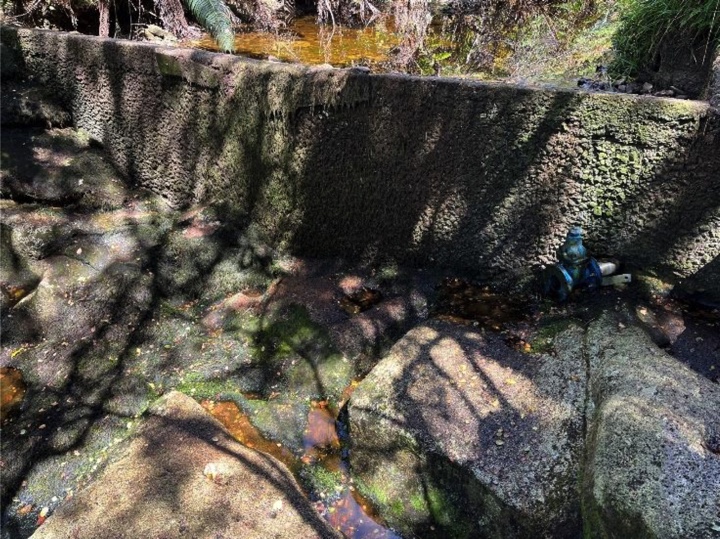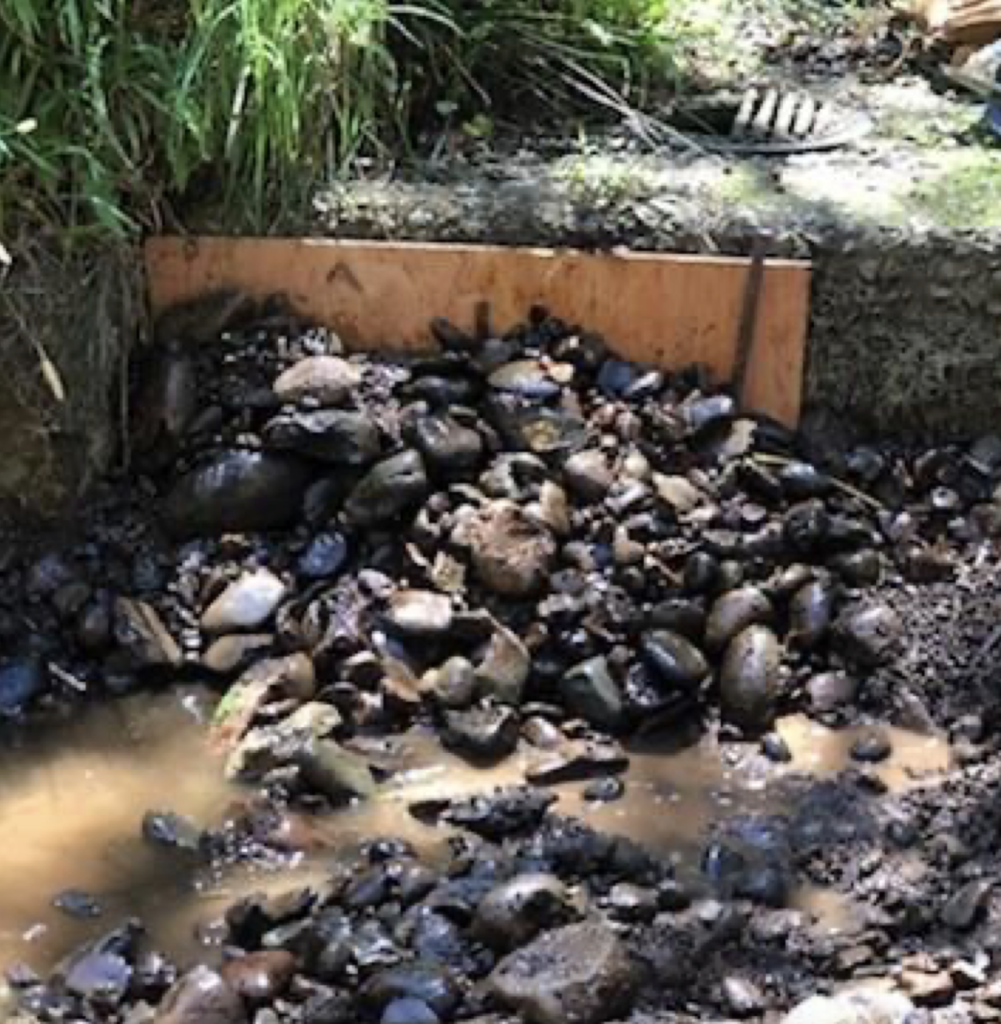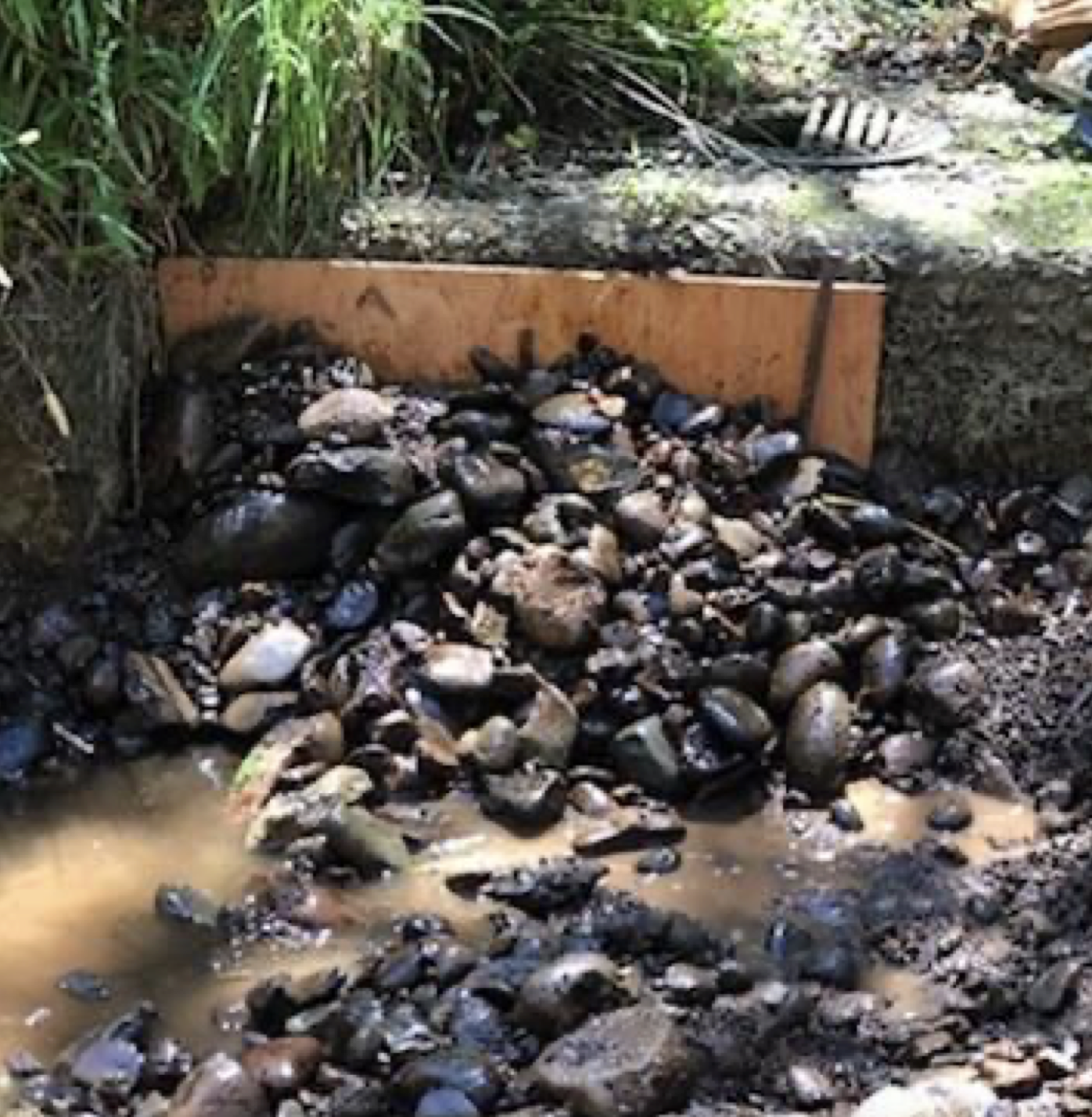In April, press releases from the state Commission on Water Resource Management and the Earthjustice law firm trumpeted the commission’s decision that month to restore five streams on Molokaʻi for the first time in more than a century.
Broadcast, print, and online media all ran stories about the community-led effort to end the excessive diversion of stream water by Molokaʻi Properties, Ltd., owner of Molokaʻi Ranch, and to keep that water in the streams.
In July 2019, Earthjustice, on behalf of Molokaʻi Nō Ka Heke, had filed with the commission a waste complaint against MPL and a petition to amend the interim instream flow standards of Kawela, Kaunakakai, Manawainui, and Waikolu streams, which the company had long diverted for its cattle and farming operations.
MPL ceased its commercial operations on the island in 2008 and put its lands there up for sale in 2017. Yet, as pointed out by Earthjustice, the company was diverting nine times the amount of water it reportedly used. This, while Kawela Stream had little to no water flowing to its mouth, and the ancient Hawaiian fishpond there was choked with overgrowth.
On April 19, after hours of impassioned public testimony from Molokaʻi residents and others in favor of restoration, the commission voted to amend the IIFS of East Kawela, East Kawela Tributary, West Kawela, Lualohe, and Waikolu streams. For East Kawela, the commission set an IIFS of 340,000 gallons per day, its Q50 flow. (That is the amount of water flowing in the stream 50 percent of the time.)
The commission gave MPL 180 days to explore how it would meet its water needs under the new IIFS, and ultimately, without any water from East Kawela Stream. The commission ordered that the stream be fully restored during that 6-month assessment and made clear its goal to make that permanent at some point.
“On May 11, Commission staff led a group site visit to the East Kawela intake to implement and observe the putatively historic restoration of Kawela’s flow,” according to a September 22 letter to the commission from Earthjustice attorney Mahesh Cleveland. MPL had shut off its diversion, allowing the stream to fill and overflow a pool behind a dam.
“[N]o water flowed into the East Kawela intake and Mountain Water System pipeline. Instead, nearly all the stream water flowed over the top of the dam into the stream bed, with a small additional amount of water flowing from the blue relief valve at the bottom of the dam,” Cleveland wrote.

That triumph lasted about a month.
Molokaʻi Nō Ka Heke members revisited the dam on June 23 and “found that the stream was almost entirely diverted again, with only a small trickle leaking from the relief valve,” he wrote.
Commission staff found during a follow-up visit on August 5 that only 245,000 gallons per day were flowing in Kawela Stream above the dam, and 36,000 gpd flowed below it.
Because the undiverted flow was 95,000 gpd less than the IIFS the commission had set in April, “[N]o water should have been diverted. Yet, MPL was taking a full 85 percent of the stream flows. Even worse, the 209,000 gpd MPL was diverting that day was nearly five times MPL’s stated non-potable uses of 42,000 gpd,” Cleveland wrote.

Minimal Progress
Months before Cleveland’s September letter, but after Molokaʻi Nō Ka Heke discovered the failed restoration of East Kawela, MPL attorney Darene Matsuoka updated commission staff on the company’s progress toward meeting its obligations under the commission’s April decision.
Within 90 days of the commission’s April action, MPL was to have submitted a plan for modifying the East Kawela intake, as well as a plan to modify the Lualohe intake to allow flows less than Q80 (the amount of water flowing in the stream 80 percent of the time) to be left in the stream.
And during the 180 days following the commission’s decision, MPL was to also submit documents for the abandonment of the diversions of East Kawela Tributary and West Kawela, conduct a water system audit to determine evaporative and system losses and identify ways to reduce them, analyze whether wastewater reuse is a potential alternative non-potable source, and evaluate the feasibility of reconnecting the Kamoku, Lualohe, and Kalihi diversions to the water delivery system to compensate for the reduced diversion of East Kawela Stream.
On July 19, Matsuoka emailed CWRM deputy director Kaleo Manuel and Ayron Strauch, staff hydrologist with the commission’s Stream Protection and Management Branch, relaying the company’s request to simply cap the ends of the pipes for the East Kawela Tributary and West Kawela diversions and abandon them in place. This would obviate the need for a Stream Diversion Works Permit and minimize removal costs, which MPL estimated to be $150,000 for each diversion.
With regard to the Lualohe intake, Matsuoka stated that based on a preliminary investigation, it would cost $200,000 to reactivate it. “Should MPL determine that reactivation is feasible, MPL will submit its plans to modify the intake so that flows below Q80 are left in Lualohe Stream,” she wrote.
MPL also did not want to modify its East Kawela diversion in the way commission staff had suggested in April. Staff had recommended building a concrete box to “raise the invert” of the intake so median flows remained in the stream. Matsuoka stated that MPL’s hydrologist believed that this modification would “only capture a small fraction of the additional flows with the majority flowing past the diversion and remaining in the stream.”
Although that seems to be the exact effect the commission and its staff had intended, Matsuoka suggested that the diversion instead be allowed to remain as is, with water equivalent to the IIFS returned by means of a pipe 1,000 feet downstream.
She attached plans for MPL’s proposed solution but added that the company would implement it “only if the Commission determines that flows below Q50 be left in the stream. In the event that the commission decides to ‘fully restore’ East Kawela, then the modifications would not be necessary.”
On August 30, commission staff met with MPL and its consultants to discuss the company’s various obligations. Staff noted that MPL’s proposed East Kawela IIFS solution would not meet the commission’s intent to restore stream habitat immediately below the diversion, and the proposed point of restoration could not be independently monitored by commission staff.
To address the failed restoration of East Kawela Stream, Manuel asked MPL in a September 28 letter to its attorneys to seal the intake with plywood or plastic wood “until permanent modifications are designed and approved by the Commission.”
Manuel also asked that the company submit new dam and intake modification designs.
With regard to MPL’s proposed plan for abandoning the East Kawela Tributary and West Kawela diversions, he made it clear that capping and leaving the infrastructure in place was insufficient. He recommended that all PVC piping within the high-water mark be removed from the stream channels.
An Earful
By the time the Water Commission met on October 18, MPL had blocked the East Kawela intake with a piece of plywood and submitted new designs to modify the intake to meet the Q50 IIFS.
Commission staff recommended that day that the commission approve in concept MPL’s plans to modify its diversion, with a 90-day deadline to submit a Stream Diversion Works Permit.
It also recommended that 1) the investigation into alleged violations of IIFS continue; 2) that MPL apply for a Stream Diversion Works Permit to abandon its East Kawela Tributary and West Kawela diversions within 30 days; 3) that the commission, MPL, and the Department of Hawaiian Home Lands continue to collaboratively investigate the feasibility of reactivating the Kamoku and Lualohe diversions; and 4) that commission staff, MPL, DHHL and Moloka‘i Nō Ka Heke have regular meetings — “approximately quarterly” — “to continue the dialog towards achieving the desired management goals until such time as the Commission determines the [waste] complaint is addressed.”
Matsuoka testified in support of those recommendations. Members of the public, frustrated with the apparent foot-dragging and half measures over the past six months, were not so kind.
Mahina Poepoe, a Molokaʻi resident running for the state House of Representatives, said she supported the full and permanent restoration of Kawela Stream. She accused MPL and its predecessors of being terrible water stewards. She added that the drinking water contamination caused by the Navy’s Red Hill facility on Oʻahu underscores how a single entity’s bad management can have devastating effects likely for decades to come.
“We don’t have time to wait for MPL to grow a conscience. … This is an opportunity to break that cycle and start to hold egregious water users accountable,” she said.
Matsuoka reiterated MPL’s support for a Q50 flow in East Kawela, but said it would fully restore the stream temporarily for the purposes of a study. “During that time period, East Kawela will be fully restored. Once staff and we looked at it, we can proceed so it’s based on actual data,” she said.
Commissioner Mike Buck suggested MPL could have done more in the time that it was already given to restore the stream. “Using a piece of plywood? C’mon. You can do better than that to show you’re serious,” he said.
Matsuoka pointed out that the idea came from commission staff. MPL had opened its release valve below the dam, as requested, but did not foresee that debris would clog it and result in water again being diverted. “We’re grateful for the community telling us,” she said.
She added that after Cleveland later informed her that water was still seeping around the plywood board, MPL’s system expert, ITC, came up with some new ideas and “now it looks like Kawela is completely restored.”
Timmy Leong of Molokai Nō Ka Heke questioned how long the current fix would last. “It started with great promise, but ended in disappointing failure,” he said of the commission’s April decision to restore the streams. Following the restoration of East Kawela in May, he monitored the stream flow in the months that followed.
“My record of the number of days in each month Kawela Stream flowed [was] a total of 12 days out of a whole 180 days. That’s how much stream flow came down to the bridge,” he said, adding that he was not able to monitor flows during one of the summer months.
Despite the sporadic flows, he said he saw an increase of young fish in the stream, which attracted stilts and night herons. “One of the best things was the sound of flowing water. It was music to my ears,” he said.
He said it was upsetting to see during a September site visit all of the stream flow being diverted. And on an October 14 visit, he added, “I got to witness this plywood that was supposedly to block the intake. It was also accompanied by a whole bunch of rocks. It did not stop the flow at all. … Water was flowing there at a rate you couldn’t even believe. It was like putting a band aid on a gaping wound. …

“I have a real simple solution for this whole situation. … That solution would be to just take out that Kawela intake and allow the stream to flow. Nobody will have to go there and monitor it. Nobody will have go there to maintain it.”
Teave Heen, also of Molokai Nō Ka Heke, agreed with Leong’s proposed solution.
“You know Hawaiians, we don’t like to waste — food, water and time,” she said, lamenting that 180 days had passed and the leaking continued. “The second time,” after the plywood installation — “that was hurtful. It was like a slap in the face. … They’re not taking this seriously.”
Momi Afelin, environment and natural resources manager for Sustainable MolokaʻI, added that it was unreasonable for the commission to ask the community to wait any longer to see Kawela Stream fully restored.
DHHL Reservation
Despite the community’s repeated calls for full restoration of Kawela Stream, staff’s recommendation at the October meeting was to approve diversion modifications, in concept, that would allow for just the Q50 flows to stay in the stream.
Strauch explained that this would provide sufficient water to meet all instream uses, while allowing MPL to divert enough occasional peak flow to fill its reservoirs, thereby ensuring there would be enough water to meet its own needs, as well as those of DHHL.
At its April meeting, in addition to setting interim instream flow standards for streams that feed or once fed into MPL’s Mountain Water System, the commission approved a water reservation for DHHL of 150,000 gallons per day from the system. That water would serve the department’s Kalamaʻula tract along Molokaʻi’s southern coast.
Earthjustice’s Cleveland argued in written and oral testimony that MPL did not need East Kawela to fill its reservoirs, since water from Lualohe and Kamoku would suffice.
He suggested that staff’s recommendation to have MPL and DHHL continue discussing the reestablishment of the Lualohe and Kamoku intakes indicated that MPL was trying to hand them off to the DHHL. This, at a time when MPL was supposed to have been looking for ways to wean itself off of Kawela Stream.
“We do strongly object to the recent proposal. … MPL is actively seeking to dispose of their alternatives. It flips the commission’s decision on its head,” Cleveland said.
Jonathan Scheuer, a consultant for DHHL, confirmed that DHHL and MPL had discussed the possibility of DHHL taking over the Lualohe and Kamoku intakes.
He also acknowledged that the commission’s goal has been to see full restoration of Kawela. “I don’t know if the ranch complied with seeing how much they can wring out of their system to allow for Kawela restoration,” he said, adding that he did not believe that DHHL’s water needs from the Mountain Water System should be used as an excuse to delay Kawela’s restoration.
MPL’s water system expert, Harold Edwards of ITC, informed the commission that the Mountain Water System fed four reservoirs, but they were all in disrepair. One had serious leakage problems. A second had significant liner damage while MPL had plans to line yet another.
He did not say when or whether fixes would be made so that the reservoirs performed as intended.
Commissioner Aurora Kagawa-Viviani, a professor at the University of Hawaiʻi, probed Edwards for more detail. “This was your homework assignment,” she said.
Edwards explained that, basically, MPL didn’t want to spend any money fixing its system so that Kawela could be restored. “The bigger issue with reservoirs, capital is not available,” he said. The resources at Kawela are in good condition and workable, but there is no capital to deal with Lualohe and Kamoku, he added. His estimate that it would cost $200,000 for each intake were educated guesses, he said.
“We had six months. The way I see it, as an instructor, to have nothing substantively written up is disappointing,” Kagawa-Viviani said.
Following up on her line of questioning, commissioner Neil Hannahs asked Edwards how he decided that there was no money to make the fixes, at least to the reservoirs.
“We think reservoirs are key to water security. … You said there is no capital. Where did you look? There are other programs out there to address this existential issue. Where did you look and find nothing available?” he asked,
Edwards said that was above his pay grade and let MPL respond.
Rather than answering Hannahs’ questions, Matsuoka simply gave more specifics on the reservoirs: One is beyond repair. The smallest, with a capacity to hold 4 million gallons, will not be reactivated. One with a 15 million gallon capacity is offline. And one will be reactivated.
There is potential for MPL to look at storage and build reservoirs, but it “depends on what’s available,” she added.
Hannahs was not comforted. “You’re stressing the demands on a diminishing public trust asset. … Everyone should do their fair share,” he said.
“I’ve heard no evidence we should back off the desire to restore Kawela stream to 100 percent. We’ve tried a couple of methods that haven’t worked,” he continued.
Commissioner Buck added, “Let me just remind the commission what we did approve: We said full restoration was our goal. MPL tried to add language ‘if practical.’ We objected.”
Strauch then explained again why he proposed a Q50 IIFS rather than full restoration: Under low flow conditions, Kawela Stream is not going to make it to the mouth from mauka to makai because it is a losing reach. Low flows do, however, benefit high elevation habitat, he said. And when there are high flows, the mouth sees a lot of flow.
“The recommendation is not going to affect stream flow at the mouth on a daily basis,” he said, noting that with an IIFS at Q50, low flows will remain in the stream and diversion will occur only during high flows, and what will be diverted will be Iess than half of those high flows.
“If you eliminate the ability to divert in high flow events, those reservoirs are going to remain dry,” he said.
Given that the DHHL has a water reservation of 150,000 gpd from the Hanalilolilo intake on Waikolu Stream, Strauch said additional water sources are needed to feed the reservoirs, so 150,000 gpd can be provided on a consistent basis.
In response, Scheuer said that if DHHL’s reservation of 150,000 gpd from Hanalilolio somehow affects the commission’s ability to restore Kawela, he would want the ability to explore how DHHL reservations can be secured “in a way that doesn’t harm public trust uses.”
Given that Strauch said that instream public trust uses of Kawela Stream would be protected under a Q50 IIFS, Hannahs asked Cleveland for his thoughts.
“If that same concept can work for East Kawela, that same concept can work for other, smaller intakes,” Cleveland said. During high flow events, MPL could direct water from smaller intakes into its reservoirs and there will be “far more than enough water” to meet MPL’s west-side needs of 42,000 gallons per day.
“I remind us all that we’re allowing these issues to be pretty badly confused,” he continued, noting that the Water Commission had granted DHHL a water reservation of 150,000 from the Hanaliolio intake in the Waikolu hydrologic unit.
“We want the commission to cut through all of these excuses. … You get so much more back for your buck restoring Kawela, instead of slicing and dicing all these different sources,” he said.
‘Triage’
Although Strauch’s justification for recommending a Q50 IIFS was in line with the commission’s desire to use reservoirs to reduce the need for stream water during dry times, Commissioner Buck remained committed to the full restoration of Kawela Stream.
Rather than approving MPLs plans to modify its diversion to meet the Q50 IIFS and giving the company 90 days to apply for a Stream Diversion Works Permit, as staff proposed, Buck recommended that new plans be developed to fully restore Kawela Stream instead. The permit application deadline would remain the same.
He also recommended that MPL work with commission staff to immediately achieve full restoration of Kawela in the interim until plans for a permanent solution were approved.
Buck made a motion to approve staff’s recommendations with those amendments. Commissioner Neil Hannahs seconded the motion.
Commissioner Wayne Katayama, however, questioned whether full restoration provided substantially more instream values than a Q50 flow.
Strauch said that it did not. He also noted that because the DHHL currently does not draw any water from MPL’s water system, the company’s reasonable and beneficial uses can be met with water from its reservoirs and its Hanalilolilo Diversion, which takes water from Waikolu Stream. When DHHL does choose to exercise its water reservation of 150,000 gallons per day from Hanalilolilo, MPL will not be able to meet its offstream water needs, he said.
“If we can get these [Q50] modifications installed, it’s going to make a noticeable difference on higher elevations [and] you’re still going to be able to utilize the reservoir storage capacity,” he said.
“What is the risk of going from Q50 to full restoration?” Katayama asked.
Strauch replied that it leaves fewer sources available to fill the reservoirs during small peak events. “We are promoting the use of storage though dry seasons, while we protect instream values,” he stressed.
Buck thanked Strauch for his explanation, then offered his own.
“We talk about values. What is the value of an unrestricted stream in Hawaiʻi? There are so few of them,” he said, adding that there is overwhelming community support for full restoration.
“I so honor your evaluation,” he continued. “Sometimes we have to do triage. We have to take more water out of one stream because we have so few opportunities to restore stream flow. … That is an incredible public trust value.”
ITC’s Edwards took one last stab at trying to convince the commission to stick to its Q50 IIFS for East Kawela. If the commission chooses full restoration, he warned, MPL may decide that it cannot afford to maintain the water system if it is left with the “very limited capture” from other streams.
“Somewhere down the road, when a more community-friendly, more robust MPL comes on the scene … they’ll walk away from this thing,” he said, referring to the fact that the company’s lands are for sale.
“Let us take those meager flows above Q50 [and] keep the system going and let’s give it a few years and hopefully someday there’s a community-friendly MPL that will bring back some economic activity without getting crazy,” he said.
Commissioner Kagawa-Viviani said it was wishful thinking that a community-friendly developer would come along. And in the end, she and the majority of the commission voted to support Buck’s motion. Commissioner Katayama was the sole dissenter.
Buck’s motion amended staff’s recommendations regarding modifications to the East Kawela intake, as well as the deadline by which MPL has to apply for a Stream Diversion Works Permit to abandon its East Kawela Tributary and West Kawela diversions (from 30 days to 90 days).
Staff’s recommendations calling for the continued investigation of alleged violations of the IIFS and of the feasibility of reactivating MPL’s Kamoku and Lualohe intakes remained unchanged.
MPL’s attorneys immediately requested a contested case hearing. Earthjustice’s Cleveland later made his own request for one, on behalf of Molokaʻi Nō Ka Heke.
(For more background, see our July 2019 EH-XTRA item, “Moloka‘i Group Seeks Restoration of Mountain Streams,” available on our website, www.environment-hawaii.org.)
—Teresa Dawson


Leave a Reply